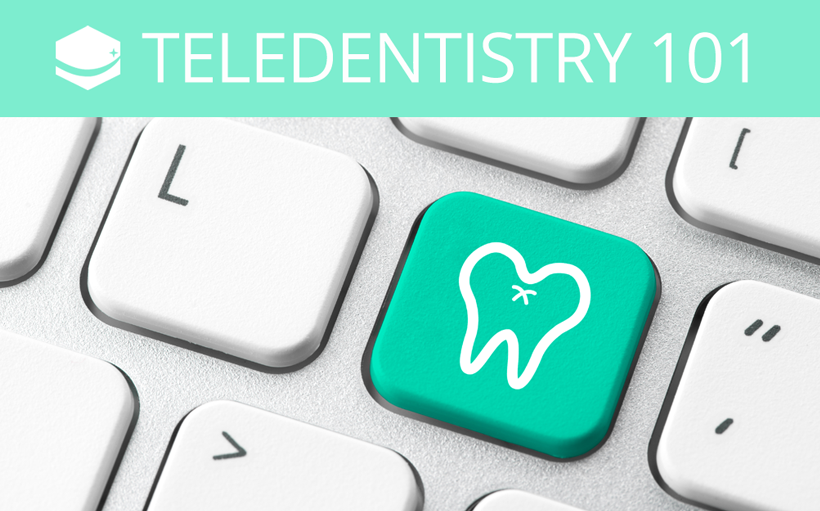
Teledentistry 101: Everything you need to know about remote dentistry

There’s never been a better time than now to start healthy living! With wearables to track your fitness (your Apple Watch, Fitbit etc), telemedicine apps to check all sorts of specific conditions, and doctor’s consultations on your smartphone, there’s a move towards healthcare being delivered at home and on demand. This is well known in many aspects of medicine and it’s becoming more popular in dentistry, too.

Examples of telemedicine:
- GP services – video chat/live chat on app with doctor
- Dermatology apps – photograph lesions and skin conditions
- Home blood tests – just a pin prick!
- Home DNA tests – swab kit
- Home eye exams – apps with phone attachments
- Home ear exams – apps with phone attachments
Why the need for teledentistry?
It’s well known that less than 50% of people visit a dentist regularly, and those who do generally leave it to emergencies. The reasons for this include fear, cost, and the feeling that treatments will be never ending. As a result, most adults avoid going to the dentist as often as they should.
The Seeking Care study (2017), shows that every week 7,500 adults in the UK go to their GP for teeth issues, such as pain and inflammation, rather than a dentist, mainly because they consider it inaccessible.

Many of the elderly population in care homes aren’t able to travel to access a dentist easily, and there are children in schools that can’t access the care they need either. In some parts of the world, many people who live in rural areas cannot visit a dental office because it’s too far to travel. For these reasons and many more, teledentistry is taking off.
What is teledentistry?
Teledentistry is the use of information technology and telecommunications for dental care, consultation, education, and public awareness. It often involves the use of telehealth systems and methodology in dentistry for remote dental care, advice, or treatment through information technology, rather than in person contact between patients and dentists.
What can be done with teledentistry?

Assessment
Teledentistry can be used for dental assessments with photos and videos taken by the patient themselves, or through existing dental records taken by a dentist in person and examined remotely.
Prescription
When a patient is in pain and needs antibiotics to cure an abscess, a prescription can be provided remotely instead of sending the patient to their GP, or doing nothing and having someone in terrible pain until they can have a physical appointment.
Supervision
Teledentistry is a cost effective way to monitor dental treatments, particularly in the case of orthodontics. It’s a great way for a dentist to supervise and monitor the progress of teeth movement remotely, without having to call the patient in every month.
As you can see, it’s a great tool for the dentist and patient to interact without the need for expensive, inconvenient in person visits.
What research has been done in Teledentistry?
In the USA, teledentistry treatments are now included in insurance coverage and in Current Dental Terminology (CDT) 2018.
Dr. Ronald D. Riggins, Chair of the CMC and the Council on Dental Benefit Programs has said that “teledentistry is a rising trend in our profession that is here to stay”.
Areas including California and Arizona (New York) began focusing on it specifically and there are programs for children to access care through this method. A six year California Study shows “virtual dental homes” are proven to be safe and effective, and a New York study highlighted the benefits of using innovative methods to deliver oral care for the underserved, particularly in rural areas.
In Australia, teledentistry is used to provide care to remote and rural communities, helping teledentists save time and money and prevent hospital admissions too. Another piece of research conducted in Brazil, where dentists have embraced the concept, concluded that telediagnosis in oral medicine, through the transmission of clinical digital images by e-mail, is perfectly acceptable.
A piece of British research concluded that the majority of UK-based orthodontic consultants support the concept of using teledentistry to make their advice more accessible to other dentists and patients.
The Arctic University of Norway conducted a massive piece of teledentistry research where they analysed teledentistry literature. They found only 53 relevant articles for this review, which represents a small percentage actively discussing telemedicine applications.
A South African PHD Thesis compares traditional dental screening to teledentistry screening, where evidence was provided to enhance the proposed eHealth patient-centred strategy for South Africa to eliminate or minimise the oral health disparities.
Straight Teeth Direct™ – teledentistry that gives you straight teeth at home
Straight Teeth Direct™ is a teledentistry platform that uses a mobile app to connect you with a registered dentist, making orthodontic treatment more accessible, convenient and affordable.
Over 70% of adults have crooked teeth and at least half of them would consider improving the straightness of their smile. However, less than 2% actually seek a form of orthodontic treatment.
This is because orthodontics is generally considered to be expensive, requires lots of visits to the dental clinic, and many people don’t even know what options are available to them.
With Straight Teeth Direct™, the whole process is done remotely, so you don’t need to visit a dentist in person, providing you saw one for an exam in the last 6 months. You’ll be assigned to a dentist who reviews your dental records, prescribes your treatment, and monitors your progress remotely. It’s super convenient because all the reviews are done through the app on your computer, or your iPhone or Android smartphone.

You receive a SmileBox™ kit at home to take impressions of your teeth, so that your clear aligners can be produced and shipped straight to you. Your personal dentist will then be there every step of the way until you get the results you want.
With this teleorthodontic process, no corners are cut when it comes to patient care and treatment transparency, the results are just as good, and all without breaking the bank or visiting your dentist every month.
The price is on average 50-70% cheaper than other brands of aligners. The treatment is fixed at 1500€/£1,350 (for both the top and bottom teeth) depending on the position of your teeth. This includes a set of removable retainers at the end of the treatment, too. By breaking down the cost and paying €170/£150 a month, it’s not going to affect your lifestyle.
If you’re ready to get started, head over to your free e-consultation. You’ll be asked to submit a few photos of your teeth and answer some simple questions. This stage of the process is free and you can ask all your questions when you’ve got the results – it’s just like a consultation, but virtual and free!

Not quite sure yet?
Fill in your email and we'll send you more details!















